 Image search results - "ring" Image search results - "ring" |
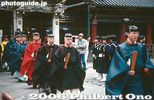
Also called "Sennin Gyoretsu" (1,000-person Procession 千人行列), this is Nikko's largest festival held on May 17-18. The highlight is a long procession of over 1,000 people dressed in various costumes.The three portable shrines are dedicated to the spirits of Tokugawa Ieyasu, Toyotomi Hideyoshi, and Minamoto Yoritomo. Photos start with May 17 at Toshogu Shrine, when priests gathered for a ceremony. 発興祭
|
|
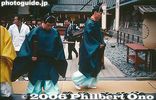
Prayer ceremony by priests
|
|
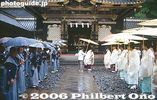
In front of the portable shrine storehouse for the three mikoshi. A ceremony is held to transfer the spirits from the main shrine to the portable shrines. 神輿舎にて宵成渡御This building is right next to the famous Yomei-mon Gate at the Toshogu Shrine.
神輿舎にて宵成渡御
|
|
|

The three portable shrines (mikoshi) are then carried out of the storehouse to be taken to Futarasan Shrine.
|
|
|
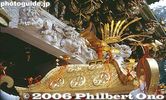
Passing under Yomeimon Gate.
|
|
|
|
|

JR Kami-Suwa Station
|
|
|
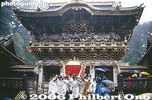
Coming down from Yomeimon Gate (National Treasure). 陽明門The gate is a National Treasure and symbol of Nikko.
陽明門
|
|
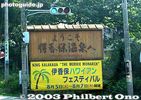
Ikaho is also a sister city of Hawaii island. During Aug. 5-7, 2003, Ikaho hosted the 7th King Kalakaua Merrie Monarch Hawaiian Festival featuring hula performances by numerous Japanese hula groups.
|
|
|

In the evenings, Hawaii's top hula halau (winner of the Merrie Monarch Festival in Hawaii) performed as the festival's main event. Photo: Flags of Hawaii and Ikaho town (merged with Shibukawa in 2006).
|
|
|
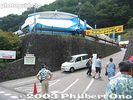
Town parking lot with a makeshift stage and main venue of the festival. The "Merrie Monarch" refers to King David Kalakaua who reigned over the Hawaiian Kingdom 1874-1891. He promoted hula in Hawaii as well as Japanese immigration to Hawaii.
|
|
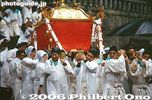
A short path leads to Futarasan Shrine.
|
|
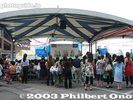
Canopy for the spectators fronting the main outdoor stage.
|
|

Passing under the torii at Futarasan Shrine. 二荒山神社二荒山神社
|
|
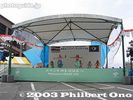
Main stage where many Japanese hula troupes performed during the day for three days. Free admission.
|
|

Passing under the torii at Futarasan Shrine. 二荒山神社二荒山神社
|
|
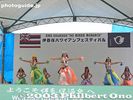
Tahitian dances were also performed.
|
|
|
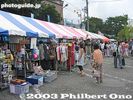
Hawaiian souvenirs for sale.
|
|

Entering Futarasan Shrine's Haiden Hall. All three portable shrines are taken to this hall. 二荒山神社 拝殿
|
|
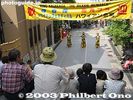
Ikaho is famous for the Stone Steps lined with shops. A section of it also served as a second hula stage during the day.
|
|
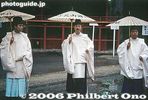
Priests on a rainy day.
|
|

Hula on the Stone Steps 石段街
|
|

The spirits of Tokugawa Ieyasu, Toyotomi Hideyoshi, and Minamoto Yoritomo in the three portable shrines are then transferred to Futarasan Shrine. The mikoshi spend the night here.
|
|

Kami-Suwa Station platform with hot spring foot bath
|
|
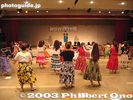
Hula workshops are also offered during the day at cost. A famous kumu hula teacher from Hawaii teaches the class.
|
|
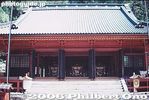
May 18: At 10:35 am, the spirits are transferred from Futarasan Shrine back to the portable shrines.Futarasan Shrine's Haiden Hall.
二荒山神社 拝殿
|
|

Portable shrine in Futarasan Shrine's Haiden Hall.二荒山神社 拝殿
|
|

Other workshops are held such as ukulele lessons and a lei-making class.
|
|
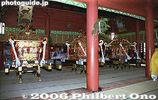
The three portable shrines (mikoshi) in Futarasan Shrine's Haiden Hall. 二荒山神社 拝殿
|
|
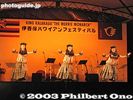
In the evenings, the overall winner of the annual Merrie Monarch Festival in Hawaii performed on stage. In 2003, it was Hula Halau 'O Kamuela from Oahu. They performed both the ancient hula kahiko dances (pictured here) and modern auana dances in Ikah
|
|
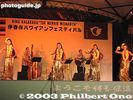
The Ikaho hula festival is officially sanctioned by The Merrie Monarch Festival, held in spring in Hilo, Hawaii. It is the most important and prestigious hula competition.
|
|

Mikoshi bearers standing by.
|
|
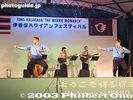
Hula is also performed by men. These photos were taken during the 7th Ikaho Hawaiian Festival (Aug. 5-7, 2003).
|
|

Mikoshi bearers standing by.
|
|

First group of mikoshi bearers fall in line.
|
|
|
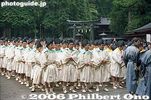
Second group of mikoshi bearers fall in line.
|
|
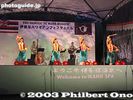
They wore a variety of colorful costumes and used various hula instruments such as these frayed bamboo sticks called Pūʻili.
|
|
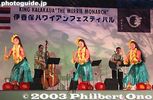
Modern hula dances such as this one is mainly for tourist entertainment.
|
|
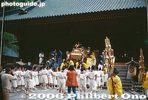
Carrying out the mikoshi from Futarasan Shrine.
|
|
|
|
|

Who says money can't buy happiness?
|
|

Hie Jinja Shrine
|
|

Carrying out another mikoshi from Futarasan Shrine.
|
|
|
|

In the bamboo forest is one of Tokyo's 57 Famous Natural Springs.
|
|

Flowering crab apple (Hanakaido in Japanese). This is early April. 花海棠
|
|

Straw ring and Hie Jinja Shrine's Shaden Worship Hall. 社殿
|
|
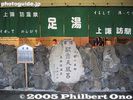
Hot spring foot bath
|
|
|
|

One of Tokyo's 57 Famous Natural Springs 竹林公園・東京の名湧水57選
|
|

Flowering crab apple (Hanakaido in Japanese) 花海棠
|
|
|

After the bamboo sticks, the girls used a gourd drum called ipu.
|
|

Clear water, but I could not find any spot where the water was gushing out.
|
|

Flowering crab apple (Hanakaido in Japanese) 花海棠
|
|
|
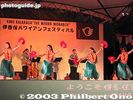
Finally, they use feathered gourd rattles called Ulīʻulī.
|
|

Flowering crab apple (Hanakaido in Japanese) 花海棠
|
|

Carrying out another mikoshi from Futarasan Shrine.
|
|
|

Flowering Crabapple and ornamental peaches ハナカイドウとハナモモ
|
|
|
|
|

In case you fall into the pond...
|
|

Flowering Crabapple and ornamental peaches ハナカイドウとハナモモ
|
|
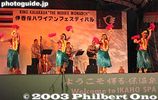
They are professional hula dancers, some of the best in the world.
|
|
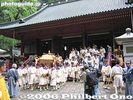
Carrying out another mikoshi from Futarasan Shrine.
|
|

The kumu hula is Kamana'o Anson Kauionalani or Kaui for short. He does a solo dance here. The music was performed by a wonderful Hawaiian trio called 'Ale'a.
|
|
|
|
|
|
|

Natural spring 湧水
|
|

Grounds of Futarasan Shrine, the starting point of the "1,000-Person Procession." 千人行列
|
|

Natural spring
|
|

Hot spring foot bathThat's not me in the picture.
|
|
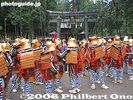
The warriors are the procession's main attraction.Waiting near Futarasan Shrine's torii.
|
|

Natural spring 湧水
|
|

Both men and boys wear the warrior costumes.
|
|
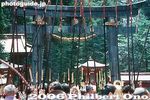
Futarasan Shrine's torii
|
|
|
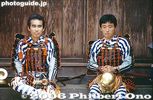
Cool heads.
|
|
|
|

Posing with maybe with their school teacher.
|
|
|
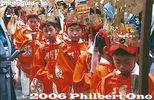
Chigo children 稚児, Nikko
|
|
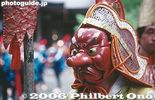
Over 50 different costumes are featured in the procession.
|
|

Onbashira rope on train platform
|
|
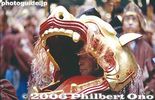
The procession's starting point at Futarasan Shrine is a great photo op.
|
|
|

The procession includes about 18 horses.
|
|

Shrine priests sitting
|
|

Shrine priests standing
|
|
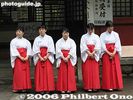
Shrine maidens 巫女
|
|

All we could see were the kite strings.
|
|
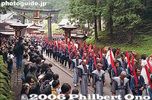
At 11:00 am, the procession starts. They leave Futarasan Shrine through this torii. 上新道上新道
|
|

The sign says "Arigato gozaimasu" (Thank you). I guess the bamboo was hungry for a giant kite.
|
|
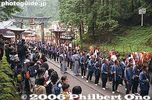
This short path goes to the Omotesando main promenade.上新道
|
|

This was the 2nd time in three years for the giant kite to meet a major accident. In 2005, the kite broke in half in the sky and crashed into a crowd of people below.
|
|
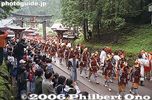
Warriors make their way through.
|
|

"So how does it look?" "It looks pretty bad, boss."
|
|
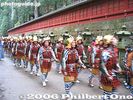
This warrior procession is said to be a reenactment of Shogun Tokugawa Hidetada's visit to Toshogu Shrine, dedicated to Tokugawa Ieyasu. Successive shoguns visited the shrine as well.上新道
|
|

Members of the giant kite preservation society look on as the disappointing and heartbreaking situation is assessed.
|
|

Onbashira rope on train platform
|
|

Rear view
|
|

Hanging on to the strings...
|
|
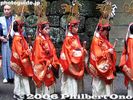
Chigo children wearing an elaborate crown with the signs of the eto Oriental Zodiac. NikkoNikko Grand Spring Festival in May.
|
|

As I expected, they soon started cutting down the bamboo.
|
|
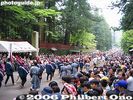
Omotesando main promenade 表参道
|
|

No way would this guy be able to pull the kite out of this one...
|
|
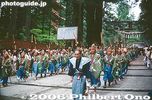
Start of the Omotesando with Ichino-torii in the background. 一ノ鳥居
|
|

How he wished that he could just pull the strings to drag the kite out.
|
|
|

The kite strings were too tangled in the bamboo.
|
|
|
|

A closer look at the accident scene. The kite suffered significant damage, and it took about 20 days to repair.
|
|

Beware of horse droppings
|
|

As I predicted again, they started disassembling the kite so they could roll (crumple) it up and carry it out. The kite was not flown again for this festival. It was to be its final flight since it will be replaced next year.
|
|
|
|

Sacred music musicians
|
|

Dept. store
|
|
|
|
|

Mikoshi passing through Ichino-torii
|
|

Mikoshi
|
|
|
|
|

The Boy Scouts collect offerings (excluding horse droppings) thrown on the ground by spectators.
|
|
|
|
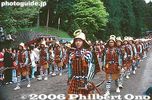
Warriors coming down the Omotesando. 武者行列
|
|
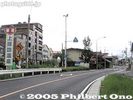
Kami Suwa Onsen (Spa)
|
|

Warriors coming down the Omotesando. 武者行列
|
|

Face of a samurai.
|
|

Banners leading the procession.
|
|
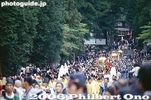
Omotesando is the main part of the route to watch the procession. It is the shrine's largest avenue.
|
|
|
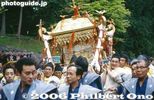
Mikoshi coming through.
|
|
|
|
|
|
|
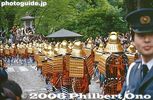
This is near the end of the Omortesando and they turn left to go to the Otabisho resting place.
|
|

12 noon: Otabisho resting place. They arrive and have lunch. The three mikoshi are stored in the building on the upper left. 御旅所御旅所
|
|
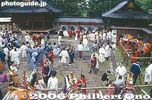
Otabisho 御旅所
|
|

Mikoshi stored in the Otabisho's Shinden Hall, a resting place for spirits in transit. 御旅所 御神殿
|
|

Procession banners
|
|
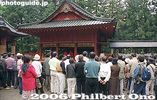
Ceremony at the Otabisho. 御旅所祭
|
|
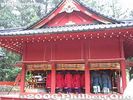
Ceremony at the Otabisho. 御旅所祭 拝殿
|
|
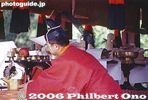
Ceremony to give offerings to the shrine deity. 三本立七五膳Sanbon-date Shichi-jugo zen
三本立七五膳
|
|

Ceremony to give offerings to the shrine deity. 三本立七五膳Sanbon-date Shichi-jugo zen
三本立七五膳
|
|
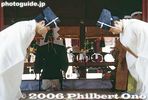
Sanbon-date Shichi-jugo zen
三本立七五膳
|
|
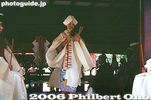
Ya-otome no Mai Sacred Dance 八乙女の舞
|
|
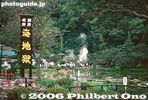
Umi Jigoku (Ocean Hell) 海地獄
|
|

Offerings of sea bream (tai)Sanbon-date Shichi-jugo zen
三本立七五膳
|
|

Lotus pond in Umi Jigoku
|
|
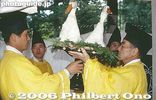
Offering of ducks (dead)
|
|

Umi Jigoku 海地獄
|
|
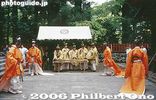
Azuma-asobi no Mai Dance 東遊の舞
|
|

Umi Jigoku. A hell which can never freeze over. 海地獄
|
|

Umi Jigoku. 海地獄
|
|

What happened to the white roof for the musicians? Azuma-asobi no Mai Dance 東遊の舞These pictures were taken in different years and combined.
|
|

Azuma-asobi no Mai Dance 東遊の舞
|
|
|
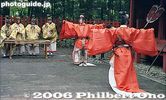
Azuma-asobi no Mai Dance 東遊の舞
|
|

Yama Jigoku (Mountain Hell) 山地獄
|
|
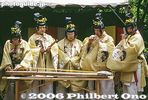
Azuma-asobi no Mai Dance musicians
|
|

Hippo at Yama Jigoku (Mountain Hell) 山地獄
|
|

These two performed the Yaotome-no-Mai. They are leaving the building.
|
|
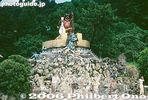
Kamado Jigoku かまど地獄
|
|
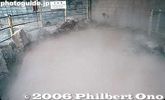
Mud spring 泥沼湯
|
|
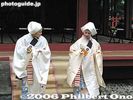
Dancers leaving the building
|
|
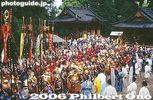
Near departure time at Otabisho
|
|

Oniyama Jigoku (Ogre Mountain Hell) 鬼山地獄
|
|
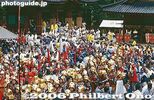
People get ready to leave and go back to Toshogu Shrine.
|
|
|
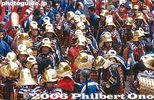
Warriors with shiny gold helmets.
|
|
|
|
|
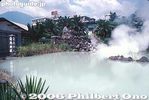
Shiraike Jigoku (White Pond Hell) 白池地獄
|
|
|
|
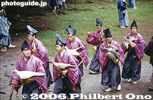
Wooden birds
|
|
|

1:00 pm: Departure at Otabisho
|
|
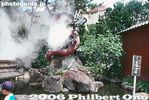
Golden Dragon Hell 金壟地獄
|
|
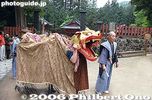
Lion
|
|
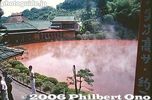
Chinoike Jigoku (Blood Pond Hell) 血の池地獄
|
|
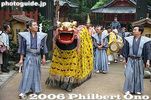
Another lion (shi-shi)
|
|
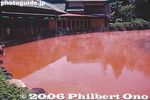
Chinoike Jigoku (Blood Pond Hell) 血の池地獄
|
|
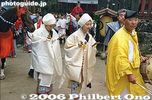
Dance maidens
|
|
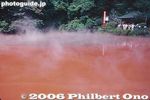
Chinoike Jigoku (Blood Pond Hell), Beppu, Oita 血の池地獄
|
|
|
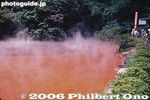
Chinoike Jigoku 血の池地獄
|
|
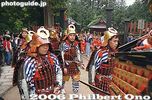
Warriors leaving the Otabisho.
|
|

Tatsumaki Jigoku (Tornado Hell) 龍巻地獄A short geyser.
|
|
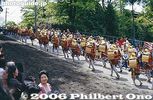
Warriors walk back up the slope in front of the Otabisho.
|
|
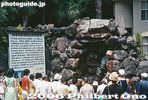
Tatsumaki Jigoku (Tornado Hell) 龍巻地獄
|
|
|
|

Tatsumaki Jigoku (Tornado Hell) 龍巻地獄
|
|

Mikoshi is carried out of the Otabisho.
|
|

Tatsumaki Jigoku (Tornado Hell) 龍巻地獄
|
|

Mikoshi is carried out of the Otabisho.
|
|

The three mikoshi are carried out of the Otabisho.
|
|
|
|

Leaving the Otabisho.
|
|
|
|
|

Shrine priest
|
|

Heading to Omotesando. They follow the same route back.
|
|

Chigo children, notice the Oriental zodiac animals on their crowns.
|
|
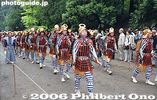
Warriors on Omotesando
|
|
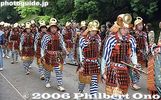
Warriors on Omotesando
|
|
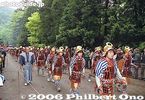
Warriors on Omotesando
|
|
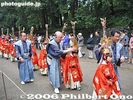
Chigo children and assistants make sure the crown doesn't fall off.
|
|
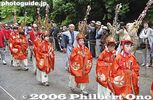
Those crowns are heavy.
|
|
|
|

Warriors and Five-story Pagoda
|
|

Mikoshi enter the Ichino-torii
|
|

Mikoshi and Five-story Pagoda
|
|
|
|

Mikoshi and Five-story Pagoda
|
|
|

Warriors going through the Omote-mon Gate.
|
|
|
|
|
|

Mikoshi coming through Ichino-torii
|
|
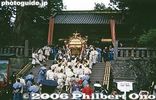
Mikoshi going up to Omote-mon Gate
|
|

Another mikoshi going up to Omote-mon Gate
|
|
|
|
|
|
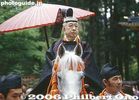
Shrine priest
|
|

Ichino-torii
|
|

1:30 pm: The end (path to Futarasan Shrine). A similar festival is held in Oct., but on a smaller scale and with only one mikoshi.After the festival ends, there's enough time to see the shrine.
|
|

JR Atami Station
|
|

Gift shops next to Atami Station. The architecture doesn't match the station at all.
|
|
|

In front of Atami Station.
|
|
| 1374 files on 6 page(s) |
1 |
 |
 |
 |
|